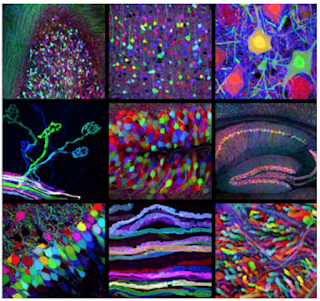Howard Gardner mentions in his book named “Art, Mind, And Brain – A Cognitive Approach To Creativity” that human creative processes are manifest in the arts, and through studying cognitive psychology, the basic laws of human thoughts can be revealed. In addition, Semir Zeki, a neuroscientist at University College London, says that art is governed by the laws of the brain, and he also says that it is brains that see art and it is brains that make art.
There have been a lot of researches going on about inter-relationship between neuroscience and art, especially regarding what happens in the
brain during the creative processes which manifests in the art. Many researches
have demonstrated that our mind and body including our simple or complex
behavior such as creative activity are linked to brain. One
example is a new report from National Endowment for the Arts(NEA) titled How
Creativity Works in the Brain. In this report, many experts from different disciplines
including neurologists, artists, and cognitive psychologists examined the links
between Arts, Learning, and Neuroscience, trying to answer to the questions
such as “What are the links between brain function and creativity? How can this
knowledge affect the way we learn, work, and thrive?” Bill O’Brien, an NEA senior
advisor, furthermore, mentions that “The time is
ripe for bringing together artists, scientists, and educators to
collaboratively confront the question of how creativity functions in the brain.”
“Neuroaesthetics” is a term which has been coined to refer to the project of studying art using the methods of neuroscience, which has become a very hot field. Neuroesthetics utilizes neuroscience to explore aesthetic experiences at the neurological levels, which has been attracting scholars from many different disciplines.
Researchers are looking to neuroscience for answers behind why the
human brain finds artistic works like
DaVinci’s Moan Lisa so alluring.
There have been lots of neuroscientists who have been answering
to those questions. Christopher deCharms who is a neuroscientist
and inventor demonstrates a new way to use fMRI to show brain activity —
thoughts, emotions, pain — while it is happening. In his talk, he
mentions that we can actually see how we feel.
In addition, Santiago Ramon y Cajal was a young artistic person, and then
later on, became the “father of neuroscience.” He discovered a neuron,
which was proved to be the basic cellular unit of the nervous system. He called it “butterflies of the soul,” and then he also remarked that “only true
artists are attracted to science.” In the 1890s, he provided clear evidence of
distinct cerebral individuality in the form of his portraits of neurons, revealing
the composition of mysterious mental matter.
Drawing of a Purkinje cell in the cerebellum cortex done by
Cajal, after using the Golgi stain.
Jeff Lichtman and his colleagues in the Department of
Molecular and Cell Biology at Harvard University produced proteins in
four different ‘primary’ colors (red, yellow, cyan, and orange) by using a
combination of genes from natural sources such as bioluminescent jellyfish or
corals and man-made constructs. More specifically, the genes were inserted into
the mice genome through the Cre/Lox recombination method which was developed by
Du Pont in the 1980s, allowing tissue specific modification. Here, only in the
central nervous system cells, the genes are expressed.
There is also a neuroscientist, who devoted his career to
explore the intersection of art and neuroscience: Greg Dunn. In 2011, he received
his doctorate in neuroscience, and then spent his life exploring
inter-relationship between art and neuroscience. Greg, inspired by the
microscopic view of the nervous system, painted neuroscience themes in the
Asian art style, which I thought quite interesting.
Spinal Cord by Greg Dunn
Artistic interpretations of the brain by children of the National Institute on Aging and the National
Institute of Drug Abuse intramural programs were quite amazing as well.
Artistic interpretations of the brain by children of the
National Institute on Aging and the National Institute of Drug Abuse intramural
programs
By exploring this field throughout this week, I could learn
quite a lot about art, neuroscience esp. brain functions, and neuroaesthetics.
Especially, the findings by Patrik Vuilleumier at the University of Geneva and
colleagues were quite interesting. They found that the amygdala, which
is known to be a part in the brain involved in emotions and the "flight or
fight response," responds more to blurry photos of faces than sharply detailed images.
References
"A Portrait of
the Scientist as a Young Artist." The Beautiful Brain RSS.
N.p., 01 July 2010. Web. 15 May 2016.
"Art and the Limits of
Neuroscience." Opinionator Art and the Limits of Neuroscience
Comments. N.p., n.d. Web. 15 May 2016.
"Art of Neuroscience." CNN.
Cable News Network, n.d. Web. 15 May 2016.
"Art of Neuroscience." Society
for Neuroscience. N.p., n.d. Web. 15 May 2016. "Art of Neuroscience."
"CONNECT WITH US." Salzburg
Global Seminar - Home. N.p., n.d. Web. 15 May 2016.
"Discover Cajal." The
Beautiful Brain RSS. N.p., 28 June 2011. Web. 15 May 2016.
"News." Links between
Arts, Learning, and Neuroscience Examined in New NEA Report. N.p., n.d.
Web. 15 May 2016.
"News & Events." Stanford
University Co-SIGN. N.p., n.d. Web. 15 May 2016.





No comments:
Post a Comment